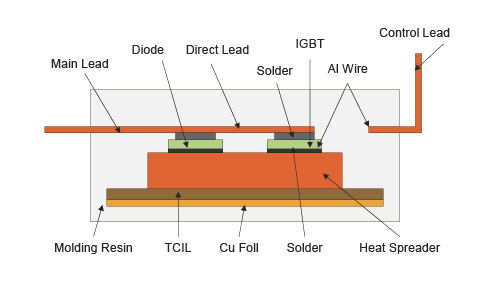In accordance with the European Union’s General Data Protection Regulation (GDPR), we are committed to safeguarding and ensuring your control over your personal data. By clicking “Accept All” you are permitting us to use cookies to enhance your browsing experience, assist us in analyzing website performance and usage, and deliver relevant marketing content. You can manage your cookie settings below. By clicking “Confirm” you are agreeing to the current settings.
CMC AlSiC Heat Spreader
-
Excellent mechanical stability under high-temperature processing
-
No warpage after thermal cycling and soldering tests
-
Low coefficient of thermal expansion (CTE), suitable for matching semiconductor materials
-
High thermal conductivity for rapid and efficient heat dissipation
-
Significantly lighter than copper
-
Ultra-thin form factor, with thickness down to 1 mm
-
Passes vibration-damping tests with ease
-
Longer thermal cycling lifespan than copper
(Reference: Infineon AN2019‑05 report) -
Ideal replacement for Copper (Cu) or Molybdenum-Copper (Mo‑Cu) in power modules
Ceramic matrix compound increases thermal conductivity and efficient heat dissipation at electronic components.
Applications:Power Electronics、Semiconductor Packaging、Electric Vehicles, EVs、Aerospace & Defense、High-Performance Computing & Data Centers、Renewable Energy Systems、Precision Machinery & Instrumentation、Telecommunications Equipment、Medical Electronics、Industrial Automation、Laser and Optoelectronics、Test & Measurement Instruments.
As a composite material, our AlSiC (Aluminum Silicon Carbide) offers an ideal balance of properties for high-performance thermal management. With a coefficient of thermal expansion (CTE) ranging from 6 to 12×10⁻⁶/K, AlSiC closely matches that of common ceramic substrates such as AlN (4.5×10⁻⁶/K) and Al₂O₃ (6.7×10⁻⁶/K), unlike traditional metals such as copper (17.5×10⁻⁶/K) or aluminum (22.5×10⁻⁶/K). This CTE compatibility significantly enhances thermal stability in IGBT power modules and IC packaging. AlSiC is also only one-third the density of copper, making it an optimal choice for heat spreader and baseplate applications where weight reduction is critical. The material’s unique structure leverages the high thermal conductivity of aluminum and the excellent heat dissipation capacity of silicon carbide, ensuring both efficient heat transfer and stable performance. Additionally, the presence of covalently bonded SiC particles provides high bending strength, stiffness, toughness, and wear resistance. Lightweight and easily machinable, AlSiC is suitable for a wide range of industries, including electronics, automotive, aerospace, high-precision machinery, and green energy.
Specification:
| Material | Density (g/cm³) |
Thermal conductivity (W/m·K @25°C) |
Coefficient of Thermal Expansion (PPM/°C) |
|---|---|---|---|
| 85Mo/15Cu | 10.01 | 195 | 7.0 |
| 50Mo/50Cu | 9.51 | 230 | 10.3 |
| AlSiC | 2.7~3.0 | >180 | 7~10 |
| Cu‑AlSiC | 2.9~3.2 | >360 | 8~12 |
-

-
CMC AlSiC heat spreaders are ceramic matrix composites reinforced with SiC particles throughout an aluminum matrix, offering high thermal conductivity (>180 W/m·K) and low coefficient of thermal expansion (7–10 ppm/°C). They efficiently conduct heat away from high‑power‑density components, maintain mechanical stability under thermal cycling, and reduce thermal stress in electronic devices.








